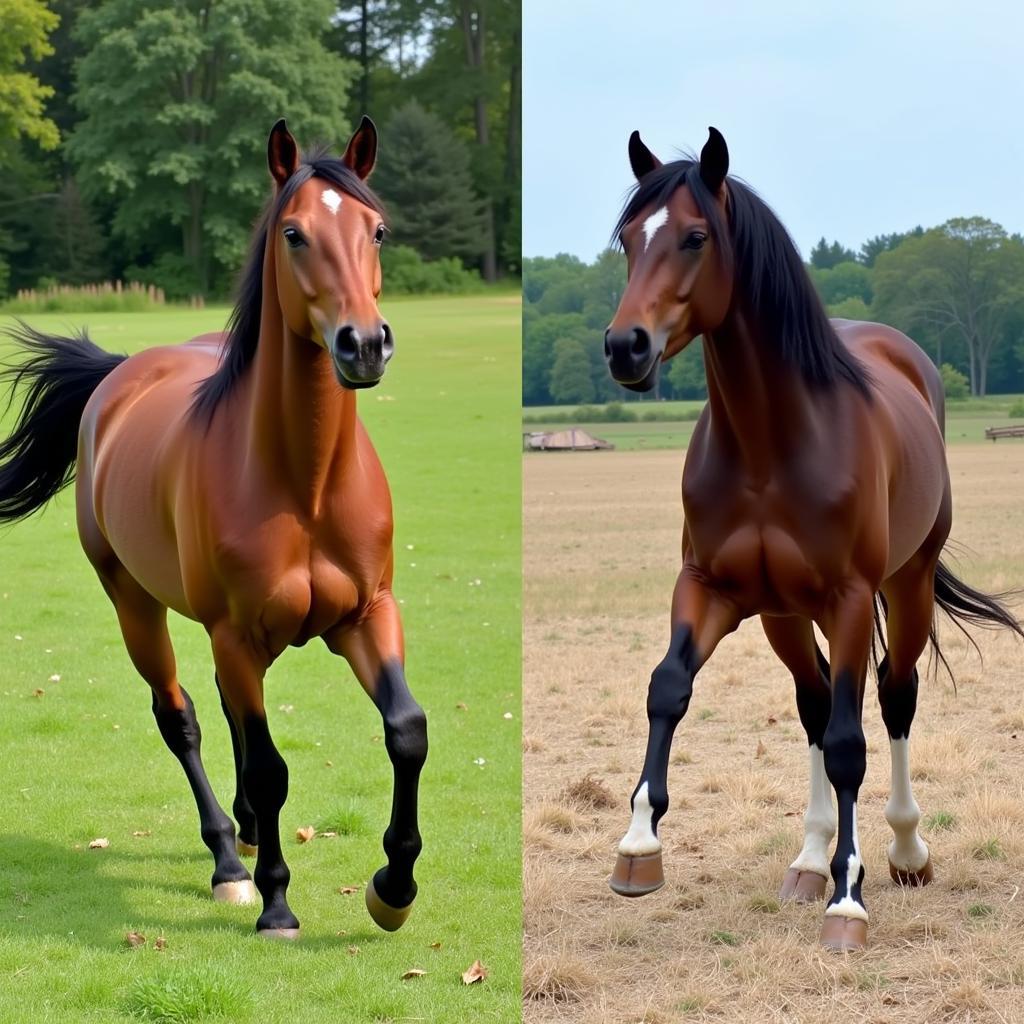Candied Horse isn’t about feeding your equine friend sugary treats. This term, often encountered in online horse communities, refers to a horse that displays overly exaggerated, almost artificial, movements, often as a result of specific training techniques. Let’s delve into the world of the “candied horse” and explore the training practices, ethical concerns, and potential health implications associated with this phenomenon.
What Makes a Horse “Candied”?
The “candied” look is characterized by extremely high leg action, an excessively arched neck, and a head held in an unnatural position, often behind the vertical. While some may find these movements visually striking, they are often far removed from the horse’s natural gaits and posture. This artificial appearance is typically achieved through restrictive training methods, including the use of special equipment like draw reins, tight nosebands, and other devices that force the horse into the desired conformation. These techniques focus on achieving a specific aesthetic rather than promoting the horse’s well-being and natural athleticism.
What are the signs of a candied horse? Look for exaggerated head carriage, often behind the vertical, extremely high stepping, and a tense, unnatural overall posture. These are often coupled with signs of discomfort or resistance from the horse.
What are the long-term effects of “candying” a horse? Prolonged use of restrictive training methods can lead to physical problems such as muscle soreness, joint damage, and even behavioral issues stemming from discomfort and stress.
Ethical Concerns Surrounding the “Candied” Look
The pursuit of the “candied” look raises significant ethical concerns within the equestrian community. Many argue that these training methods prioritize aesthetics over the horse’s physical and mental well-being. Forcing a horse into unnatural postures can cause pain, discomfort, and long-term health problems. This emphasis on artificial movement also detracts from the appreciation of the horse’s natural beauty and athleticism.
Is it ethical to train a horse to be “candied”? Many equestrians believe that prioritizing artificial aesthetics over the horse’s comfort and well-being is unethical and potentially harmful.
What are the alternatives to “candying” a horse? Focusing on correct, classical training methods that encourage natural movement, suppleness, and strength will result in a healthy and happy horse performing at its best.
 Natural Horse Movement vs. Candied Movement
Natural Horse Movement vs. Candied Movement
The Role of Training and Equipment
The creation of a “candied horse” often involves the use of specific training techniques and equipment. Draw reins, for instance, are commonly used to force the horse’s head into a specific position, often behind the vertical. Similarly, overly tight nosebands can restrict the horse’s ability to open its mouth and breathe comfortably, further contributing to discomfort and stress. While some riders may argue that these tools can be used responsibly, their misuse can have detrimental effects on the horse’s physical and mental health.
Recognizing the Signs of Discomfort
It’s crucial for horse owners and riders to recognize the signs of discomfort in a “candied” horse. These signs may include:
- Head tossing or shaking
- Resisting the bit
- Hollowing the back
- Pinning the ears back
- General signs of tension and anxiety
Dr. Emily Carter, DVM, a renowned equine veterinarian, states, “Horses are incredibly stoic animals. Even when experiencing pain, they may not always show obvious signs of distress. It’s crucial for riders to be attuned to subtle changes in their horse’s behavior and to prioritize their well-being above all else.”
Choosing a More Ethical and Sustainable Approach
Instead of pursuing the “candied” look, riders should focus on developing a harmonious partnership with their horses based on trust, respect, and understanding. This involves prioritizing the horse’s natural movement and athleticism, encouraging suppleness and strength through correct training, and avoiding any practices that cause pain or discomfort.
John Miller, a respected classical dressage trainer, advises, “True beauty in a horse comes from its natural grace and power, not from forced and artificial movements. By focusing on correct training principles, we can help our horses achieve their full potential while preserving their physical and mental well-being.”
Conclusion
The “candied horse” phenomenon highlights the importance of ethical considerations in equine training. While the exaggerated movements may be visually appealing to some, they often come at the expense of the horse’s well-being. By choosing a more ethical and sustainable approach to training, we can ensure that our horses remain healthy, happy, and able to perform at their best. Remember, a happy horse is a beautiful horse.
FAQ
- What is a candied horse? A candied horse is a horse trained to exhibit exaggerated, unnatural movements.
- Is it harmful to candy a horse? Yes, these training methods can cause pain and long-term health issues.
- What equipment is used to create this look? Draw reins, tight nosebands, and other restrictive devices are often used.
- How can I tell if a horse is uncomfortable? Look for signs like head tossing, resistance, and pinned ears.
- What are the alternatives to candying? Focus on classical training methods that promote natural movement and well-being.
For more information on ethical horse training, you might find our Dark Horse Sauvignon Blanc review helpful.
If you need assistance, please contact us: Phone: 0772127271, Email: [email protected] or visit us at QGM2+WX2, Vị Trung, Vị Thuỷ, Hậu Giang, Việt Nam. We have a 24/7 customer service team.